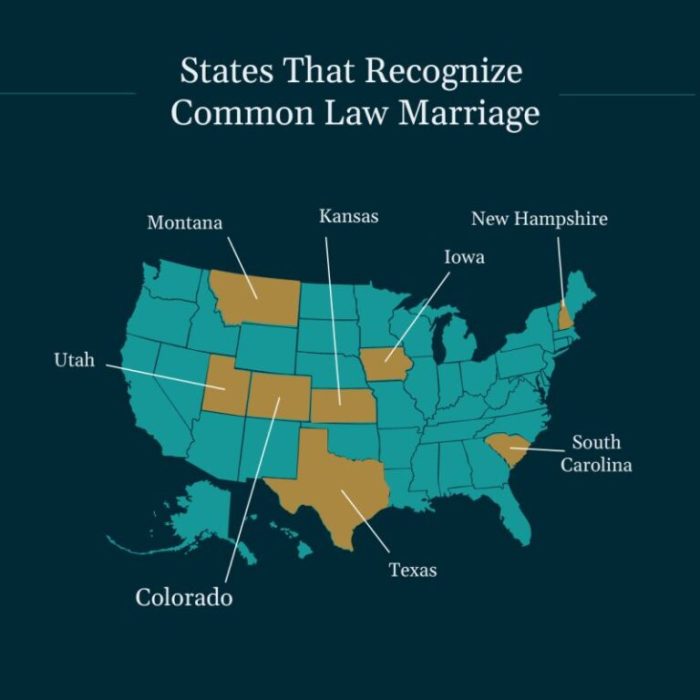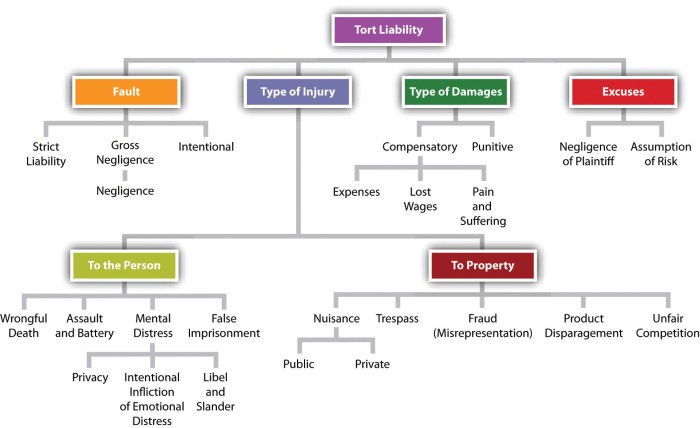
What is a common law marriage? It’s a legal relationship where two people are recognized as married without a formal ceremony or license. This concept, rooted in historical tradition, has evolved over time and is currently recognized in certain jurisdictions. While it may seem like a simple arrangement, understanding the intricacies of common law marriage is crucial to navigating its legal implications.
Throughout history, common law marriage provided a path to legal recognition for couples who couldn’t afford formal ceremonies or faced societal barriers. Today, the concept persists, but its acceptance varies widely, with some states and countries recognizing it while others do not. The requirements for establishing a common law marriage are often strict and vary from jurisdiction to jurisdiction. Understanding these requirements is vital, as failing to meet them can have serious consequences.
Definition of Common Law Marriage
Common law marriage, also known as informal marriage, is a legal concept in which a couple is recognized as married without having gone through a formal marriage ceremony. This legal recognition is granted based on their representation to the public that they are married, their intent to be married, and their cohabitation as husband and wife.
Historical Origins of Common Law Marriage
Common law marriage originated in England during the Middle Ages when formal marriage ceremonies were not always readily available. The concept was based on the idea that if a couple presented themselves to the public as married and lived together as husband and wife, they were considered to be legally married. This practice was recognized in English common law and eventually spread to the American colonies.
Comparison and Contrast with Traditional Marriage
Common law marriage differs from traditional marriage in several ways:
- Formal Ceremony: Traditional marriage requires a formal ceremony with a licensed officiant, witnesses, and legal documentation. Common law marriage does not require a ceremony.
- Legal Recognition: Traditional marriage is recognized in all states, while common law marriage is only recognized in a limited number of states.
- Legal Requirements: Common law marriage requires specific legal requirements, such as intent to be married, holding oneself out to the public as married, and cohabitation. Traditional marriage does not have these specific requirements.
Key Elements of Common Law Marriage
To establish a valid common law marriage, several elements must be met. These elements vary by state, but generally include:
- Present Intent to Marry: Both partners must intend to be married at the time they begin living together as husband and wife.
- Holding Out to the Public as Married: The couple must present themselves to the public as married, such as by using the same last name, referring to each other as husband and wife, or filing joint tax returns.
- Cohabitation: The couple must live together as husband and wife.
Requirements for Establishing a Common Law Marriage
Common law marriage, also known as informal marriage, is a legal concept in which a couple is recognized as married without a formal ceremony or license. However, establishing a common law marriage is not automatic. States that recognize common law marriage have specific requirements that must be met.
The requirements for establishing a common law marriage vary by state.
Requirements for Establishing a Common Law Marriage in Different Jurisdictions
States that recognize common law marriage generally require the following:
- Present Intent to Marry: The couple must present themselves to the public as married, and must intend to be married. This means that the couple must hold themselves out to the community as a married couple, and intend to be married, even if they don’t have a formal ceremony.
- Cohabitation: The couple must live together as husband and wife. This means that the couple must share a residence and live together as a married couple, not just as roommates.
- Holding Out to the Public: The couple must hold themselves out to the public as married. This means that the couple must present themselves as married to friends, family, and the community in general.
- Legal Capacity: Both individuals must be legally capable of getting married. This means that they must be of legal age and not already married to someone else.
It’s important to note that even if a couple meets all of the requirements for common law marriage in a particular state, the state may still not recognize their relationship as a valid marriage. This is because the laws governing common law marriage are complex and can vary significantly from state to state.
Importance of Meeting All Legal Requirements
It is crucial to meet all legal requirements for establishing a common law marriage. Failure to do so can result in significant legal consequences, including:
- Invalidation of the Marriage: If a court determines that a couple did not meet all of the legal requirements for common law marriage, their relationship may be deemed invalid. This means that they will not be legally recognized as married, and they will not be entitled to the same rights and benefits as married couples.
- Property Disputes: In the event of a separation or divorce, if a couple is not legally recognized as married, property division may be determined differently. This can lead to disputes over ownership of assets, including real estate, personal property, and financial accounts.
- Child Custody and Support: If a couple has children together, their legal status as married or unmarried can impact child custody and support arrangements. A court may not recognize the couple as married, which could affect custody decisions and support obligations.
- Tax Implications: Common law marriage can have significant tax implications, such as filing jointly on federal income tax returns. If a couple is not legally recognized as married, they may be ineligible to file jointly and may face penalties.
Consequences of Failing to Meet the Requirements
Failing to meet the requirements for establishing a common law marriage can have serious consequences, including:
- Lack of Legal Recognition: If a couple does not meet all of the legal requirements for common law marriage, their relationship will not be legally recognized as a marriage. This means that they will not be entitled to the same rights and benefits as married couples.
- Property Disputes: In the event of a separation or divorce, if a couple is not legally recognized as married, property division may be determined differently. This can lead to disputes over ownership of assets, including real estate, personal property, and financial accounts.
- Child Custody and Support: If a couple has children together, their legal status as married or unmarried can impact child custody and support arrangements. A court may not recognize the couple as married, which could affect custody decisions and support obligations.
- Tax Implications: Common law marriage can have significant tax implications, such as filing jointly on federal income tax returns. If a couple is not legally recognized as married, they may be ineligible to file jointly and may face penalties.
Recognition of Common Law Marriage: What Is A Common Law Marriage

The concept of common law marriage, while recognized in some jurisdictions, is not universally accepted. Understanding which states and countries recognize this legal arrangement is crucial for individuals considering or already in a common law marriage.
States and Countries That Recognize Common Law Marriage, What is a common law marriage
The recognition of common law marriage varies significantly across the United States and internationally.
- States in the U.S. that recognize common law marriage: Colorado, Iowa, Kansas, Montana, New Hampshire (only for inheritance purposes), Oklahoma, Rhode Island, South Carolina, Texas, Utah, and the District of Columbia.
- States in the U.S. that do not recognize common law marriage: Alabama, Alaska, Arizona, Arkansas, California, Connecticut, Delaware, Florida, Georgia, Hawaii, Idaho, Illinois, Indiana, Kentucky, Louisiana, Maine, Maryland, Massachusetts, Michigan, Minnesota, Mississippi, Missouri, Nebraska, Nevada, New Jersey, New Mexico, New York, North Carolina, North Dakota, Ohio, Oregon, Pennsylvania, Vermont, Virginia, Washington, West Virginia, Wisconsin, and Wyoming.
- Countries that recognize common law marriage: Scotland, England, Wales, and some provinces in Canada.
Legal Implications of Recognizing Common Law Marriage
Recognizing common law marriage has significant legal implications, including:
- Property rights: In states that recognize common law marriage, couples are considered legally married and have the same property rights as traditionally married couples. This includes the right to inherit property, claim spousal support, and file joint tax returns.
- Inheritance rights: If one partner in a common law marriage dies without a will, the surviving partner is typically entitled to inherit property as a surviving spouse.
- Child custody and support: In states that recognize common law marriage, the courts will treat children born during the relationship as legitimate children of both partners. This means both partners have legal obligations regarding child custody and support.
- Spousal benefits: Common law spouses may be eligible for spousal benefits, such as Social Security survivor benefits, military benefits, and health insurance coverage.
Challenges of Establishing Common Law Marriage in Non-Recognizing Jurisdictions
For couples residing in states or countries that do not recognize common law marriage, establishing such a relationship can present significant challenges.
- Lack of legal recognition: The primary challenge is the absence of legal recognition, meaning the relationship is not legally binding. This can lead to complications in various areas, including property division, inheritance, and child custody.
- Difficulty in proving the relationship: Couples seeking to establish common law marriage in non-recognizing jurisdictions must provide substantial evidence to prove their intent to be married. This can be difficult, as there are no formal legal requirements for establishing such a relationship.
- Legal disputes: In the absence of legal recognition, disputes over property, inheritance, or child custody can be more challenging to resolve. Courts may not consider the relationship as legally binding, potentially leaving couples vulnerable to unfair outcomes.
Legal Consequences of Common Law Marriage

Once a common law marriage is established, the parties are legally recognized as spouses and enjoy the same rights and responsibilities as couples in a traditional marriage. These legal consequences extend to various aspects of their lives, including property division, child custody, and inheritance.
Property Division
In a common law marriage, property acquired during the relationship is typically considered marital property, subject to division upon separation or divorce. This division is often based on the principle of equitable distribution, meaning that assets are divided fairly, but not necessarily equally. Courts consider various factors, such as the length of the relationship, the contributions of each party, and the financial circumstances of both individuals.
Child Custody
Common law spouses have the same rights and responsibilities regarding child custody as traditional married couples. This includes the right to seek custody, visitation, and child support. Courts prioritize the best interests of the child when making custody decisions, considering factors like the child’s age, health, and relationship with each parent.
Inheritance
Common law spouses are generally entitled to inherit from their deceased partner under intestacy laws, meaning that they will inherit property if the deceased partner did not leave a valid will. However, the specific inheritance rights may vary depending on state laws. It’s crucial for common law spouses to have a will in place to ensure their desired distribution of assets upon death.
Comparison with Traditional Marriage
The legal consequences of common law marriage are generally similar to those of traditional marriage. However, there are some key differences:
- Formal Recognition: Common law marriage is not formally recognized in all states, whereas traditional marriage requires a formal ceremony or license.
- Proof of Relationship: Establishing a common law marriage often requires more evidence than a traditional marriage, as courts need to verify the intent to marry and the public representation of the relationship.
- Legal Presumptions: In some states, there may be legal presumptions that apply to traditional marriages but not to common law marriages. For example, a spouse in a traditional marriage may be presumed to have the right to inherit property, whereas this may not be the case in a common law marriage.
Termination of Common Law Marriage
A common law marriage, like any other legal union, can be terminated. This can happen through various means, including mutual agreement, death, or legal dissolution. Understanding the process and potential consequences of ending a common law marriage is crucial for individuals involved.
Methods of Termination
The termination of a common law marriage can occur in a few ways, each with its own legal implications.
- Mutual Agreement: Both parties can mutually agree to end the common law marriage. This typically involves a written agreement outlining the terms of the separation, including property division, financial support, and child custody arrangements.
- Death: The death of one partner automatically dissolves the common law marriage.
- Legal Dissolution: Similar to the process of divorce, a common law marriage can be legally dissolved through a court proceeding. This is typically necessary when the parties cannot agree on the terms of the separation.
Legal Process for Dissolution
The legal process for dissolving a common law marriage often mirrors that of a divorce. This typically involves:
- Filing a Petition: One party files a petition with the court seeking dissolution of the common law marriage.
- Service of Process: The court issues a summons and a copy of the petition to the other party.
- Discovery: Both parties exchange information about their assets, debts, and other relevant details.
- Negotiation and Settlement: The parties attempt to reach an agreement on issues like property division, spousal support, and child custody.
- Trial: If the parties cannot reach a settlement, the case goes to trial.
- Judgment: The court issues a final judgment dissolving the common law marriage and outlining the terms of the separation.
Legal and Financial Consequences
The termination of a common law marriage can have significant legal and financial consequences. These may include:
- Property Division: Courts typically divide property acquired during the common law marriage equitably, meaning that each party receives a fair share.
- Spousal Support: In some cases, one partner may be entitled to receive spousal support (alimony) from the other.
- Child Custody and Support: If children were born during the common law marriage, the court will determine custody and child support arrangements.
- Debt Responsibility: Both parties may be held liable for debts incurred during the common law marriage.
- Tax Implications: The termination of a common law marriage can have tax implications, such as the need to file amended tax returns.
Ultimate Conclusion

Common law marriage, though not universally recognized, offers a unique pathway to legal recognition for couples who choose this route. However, it’s essential to understand the legal complexities involved, as the requirements and consequences can differ significantly based on location. Whether you’re considering entering into a common law marriage or simply curious about its implications, researching the specific laws in your jurisdiction is crucial. Ultimately, navigating this legal terrain requires careful consideration and informed decision-making.
Essential FAQs
Can I enter a common law marriage without knowing it?
It’s possible to unintentionally enter a common law marriage if you meet the specific requirements in your jurisdiction. However, it’s always best to be aware of the laws and make a conscious decision.
What happens if we break up?
The termination of a common law marriage follows similar procedures to traditional divorce. It’s crucial to consult with an attorney to understand the legal process and potential consequences.
Can I legally change my name to my partner’s after a common law marriage?
Yes, you can legally change your name after entering a common law marriage, but you’ll need to follow the procedures Artikeld by your local government. You’ll likely need to provide documentation of your common law marriage status.





